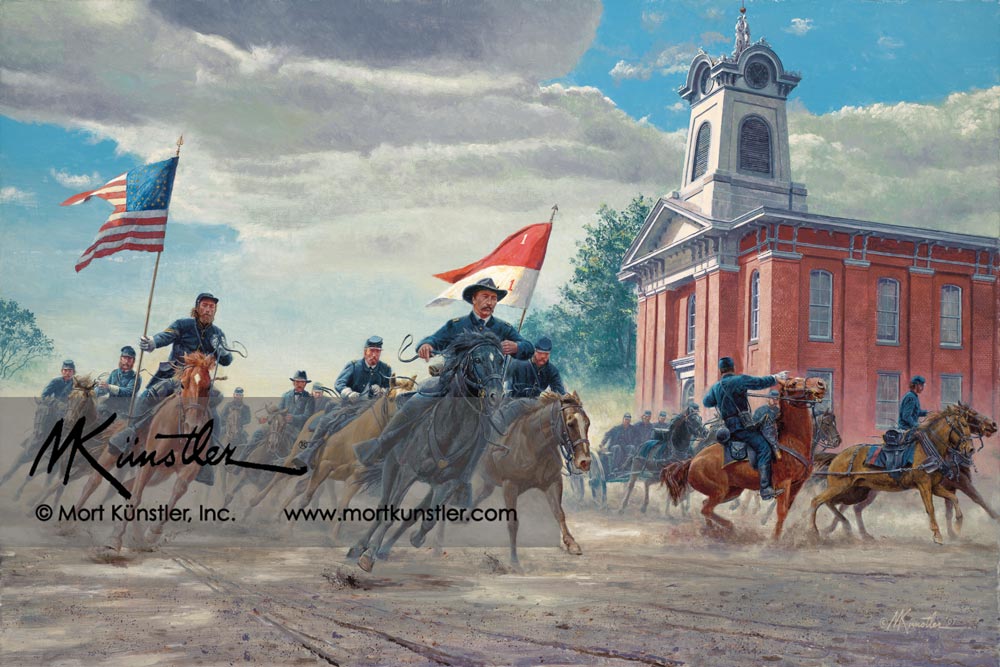The Official Mort Künstler Website
Rendezvous with Destiny - limited edition print
Rendezvous with Destiny - limited edition print
Gen. John Buford at Gettysburg, June 30, 1863
Couldn't load pickup availability
Custom framing is available for this print. Please call 800-850-1776 or email info@mortkunstler.com for more information.
LIMITED EDITION PRINTS
Paper Prints
Reproduction technique: Fine offset lithography on neutral pH archival quality paper using the finest fade-resistant inks.
Each print is signed and numbered by the artist and accompanied by a Certificate of Authenticity.
Image Size: 18” x 27” • Overall Size: 23” x 31”
Signed & Numbered • Edition Size: 750
Signed Artist’s Proof • Edition Size: 100
Giclée Canvas Prints
Reproduction technique: Giclées are printed with the finest archival pigmented inks on canvas.
Each print is numbered and signed by the artist and accompanied by a Certificate of Authenticity.
Classic Edition 22” x 33”
Signed & Numbered • Edition Size: 100
Signed Artist’s Proof • Edition Size: 10
Historical Information
He was first on the field ... and may have saved the war's greatest battle for the Union. Brigadier General John Buford was 37 years old when he led his First Cavalry Division into Gettysburg, Pennsylvania on June 30, 1863. Known to his troops as “Old Steadfast,” he was considered one of the best cavalry officers in the Northern army ... and he showed why at Gettysburg. As General Robert E. Lee moved his spread-out Army of Northern Virginia across Pennsylvania in late June, the cross roads town of Gettysburg lay on his route of march ... and also in the path of General George Meade’s pursuing Army of the Potomac. The first to fully reach the field might win the major battle both armies were seeking. Buford’s cavalry got there first, and his orders were clear: “Hold Gettysburg at all costs until supports arrive.”
Buford knew the bulk of Lee’s army was arriving from the west, so he located strong defensive lines for the Federal army on ridges flanking the town’s west side… with an excellent fall-back position on Cemetery Ridge to the rear. Buford did his job… and well. His cavalry was first to engage Lee's army, and held back its advance until the Federal army began arriving in force. When Northern troops were finally driven back on the battle’s first day, they dug in on Cemetery Ridge. There, they delivered a decisive defeat to Lee’s battle-hardened troops over the next two days, and made Gettysburg the decisive battle of the American Civil War. General Buford’s choice of defensive positions on June 30th had enabled the Union to prevail on the war's greatest field of battle.
Mort Künstler’s Comments
One of the greatest American heroes to emerge from the battle of Gettysburg was General John Buford. On the morning of June 30th – the day before the battle began – Buford led two brigades of cavalry from the Army of the Potomac into Gettysburg, supported by six pieces of artillery. Cavalry provided intelligence for the armies of the Civil War, and Buford was at Gettysburg in search of General Robert E. Lee’s Army of Northern Virginia. He learned from the town’s frightened citizens that the Confederates had been sighted to the west and north of the town. Realizing the Southern army was nearby, Buford rushed his cavalry through Gettysburg to set up defensive positions on the ridges west of town. He knew if his cavalry could slow down Lee’s advancing troops, the Federal army had a chance to hold the best high ground and win the coming battle. Thanks to him, that’s what happened.
Buford led his horse soldiers by the Adams County Courthouse in Gettysburg, and positioned his artillery on Seminary Ridge. Apparently no one has ever painted the courthouse in this setting. It’s a handsome, distinctive Civil War era building that has been beautifully restored – and I felt it was the perfect setting for this painting of Buford – Rendezvous with Destiny. I love the excitement in this painting – all the action, the bright sunlit morning, the horses and military tack and General John Buford.
It had rained in the early morning, which gave me the opportunity to paint an interesting, clearing sky radiating sunlight. The dark clouds at the top of the painting, based on weather reports of the day, lend much more drama to the scene than a blue sky. I placed the white portion of the cavalry guidon directly behind Buford’s black hat ... the darkest dark against the lightest light ... which draws the viewer to the center of interest. I was also able to use the brightest color, the red portion of the guidon, to attract attention to General Buford as the painting’s center of interest.
In a painting like this one, the action has to appear authentic – not just the faces, the weapons and equipment – all of which have been thoroughly researched and carefully depicted – but the feel of the moment has to be genuine. To achieve that, I had to paint the horses in the midst of urgent movement. Thankfully, I’ve studied and painted horses for decades, so I was able to apply that experience and knowledge to this scene. I hope the viewer who studies this painting agrees and is reminded of American heroes like John Buford and the countless others from the North and South who demonstrated such remarkable valor at Gettysburg.





